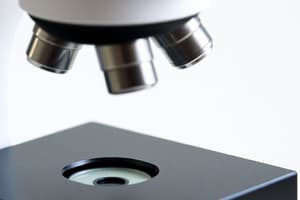Podcast
Questions and Answers
What was a significant problem with early compound microscopes?
What was a significant problem with early compound microscopes?
- They were too heavy to handle.
- They had too few lenses.
- They could only magnify up to 5x.
- They produced blurry images with halos of light. (correct)
What advancement improved the detail visible through microscopes in the 18th century?
What advancement improved the detail visible through microscopes in the 18th century?
- The addition of a built-in camera.
- The introduction of a digital display.
- The use of mirrors instead of lenses.
- The development of an achromatic lens. (correct)
How is magnification calculated using a microscope?
How is magnification calculated using a microscope?
- Power of objective lens × power of eyepiece (correct)
- Power of eyepiece ÷ power of objective lens
- Power of eyepiece + power of objective lens
- Power of objective lens - power of eyepiece
What magnification results from a 2.5x low-power objective lens and a 10x eyepiece?
What magnification results from a 2.5x low-power objective lens and a 10x eyepiece?
Which of the following statements is true about Van Leeuwenhoek's contributions to microscopy?
Which of the following statements is true about Van Leeuwenhoek's contributions to microscopy?
What significant publication did Robert Hooke release in 1665?
What significant publication did Robert Hooke release in 1665?
What was the magnification power of the microscope invented by the Janssens?
What was the magnification power of the microscope invented by the Janssens?
How did Hooke illuminate his microscope for observations?
How did Hooke illuminate his microscope for observations?
What was among the properties of cork that Hooke noted?
What was among the properties of cork that Hooke noted?
Flashcards
Magnification
Magnification
The ability to enlarge the image of an object.
Achromatic Lens
Achromatic Lens
A type of lens that reduces chromatic aberration, improving image clarity by minimizing color distortion.
Total Magnification
Total Magnification
The product of the magnification powers of the objective lens and the eyepiece.
Compound Microscope
Compound Microscope
Signup and view all the flashcards
Blurry Images in Early Microscopes
Blurry Images in Early Microscopes
Signup and view all the flashcards
Microscopy
Microscopy
Signup and view all the flashcards
Janssen Microscope
Janssen Microscope
Signup and view all the flashcards
Ocular lens
Ocular lens
Signup and view all the flashcards
Objective lens
Objective lens
Signup and view all the flashcards
Robert Hooke
Robert Hooke
Signup and view all the flashcards
Cell
Cell
Signup and view all the flashcards
Hypothetico-deductive method
Hypothetico-deductive method
Signup and view all the flashcards




